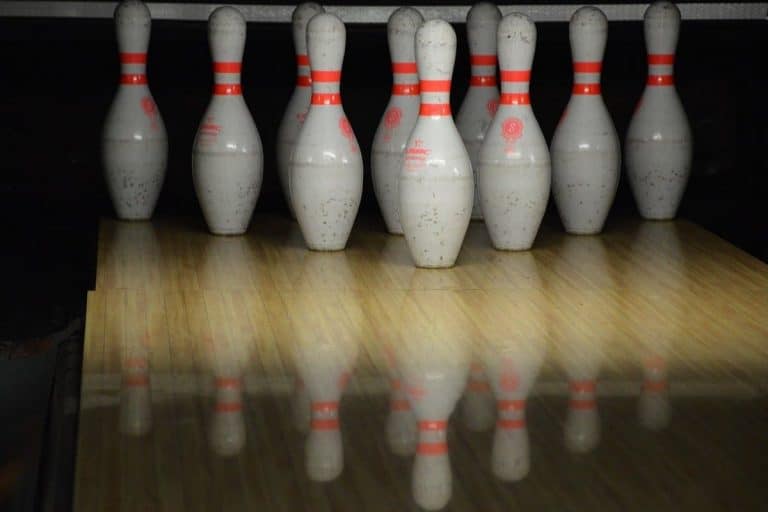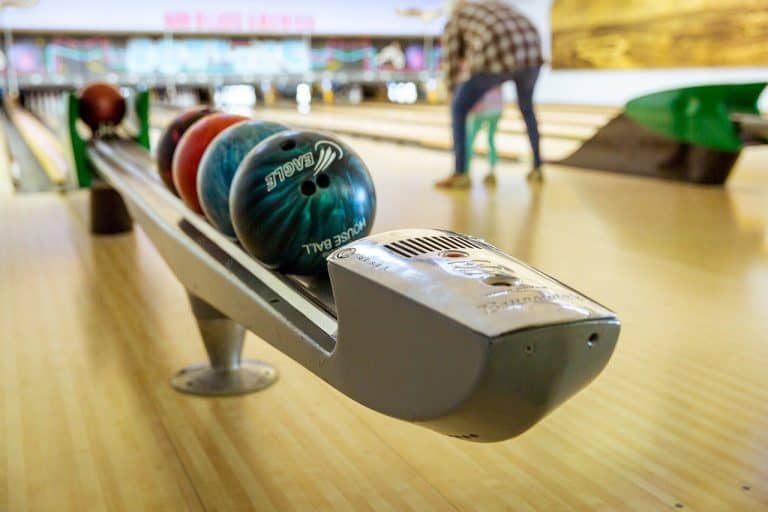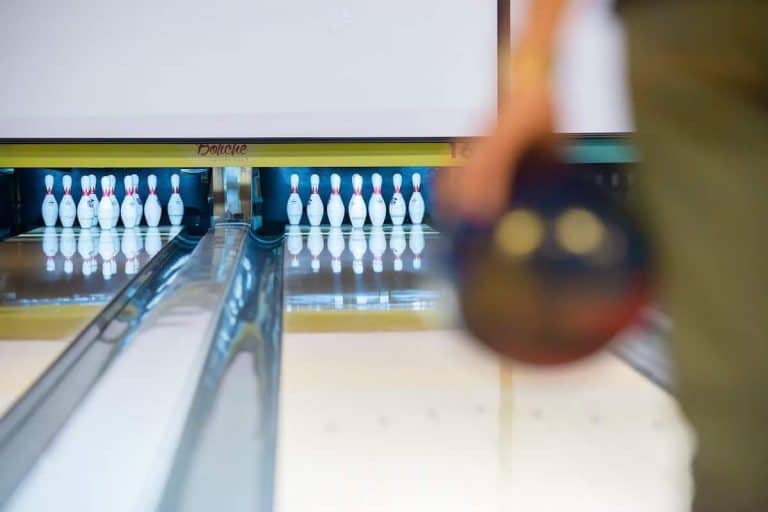3 Signs It’s Time to Resurface That Bowling Ball
Bowling balls need constant care and maintenance to maximize their lifespan and performance on the lane. One of the most important maintenance techniques is resurfacing, which you need to do regularly. What are the signs that show it’s time to resurface your bowling ball?
The signs that indicate you should resurface your bowling ball include reduced hook, scratches on the ball, and discoloration. Clean your bowling balls regularly to get the lane oil out of the coverstock’s pores. Plus, you want to resurface your balls every 60 games to ensure it’s in good shape.
In the rest of the article, I’ll elaborate on the signs that show you need to resurface your bowling balls. I’ll explain how often and how to do it at home. Finally, I’ll share some tips on storing and maintaining the balls to extend their lifespan.
The Bowling Ball Loses Its Hook
The coverstock of the bowling ball makes the ball grip the lane through friction. There are microscopic pores in the coverstock that allow for this grip.
If you don’t take care of your bowling balls regularly, they will lose their hook over time. Bowling lanes are covered with oil, and coverstocks are porous. So the oil gets into the pores, making the ball saturated with lane conditioner and decreasing the ball’s performance.
If you are a beginner or an average bowler and your ball does not hook, you may think it is because you have average bowling skills without even considering that something might be wrong with the ball. It can be a telltale sign that your ball needs resurfacing.
So, how do you tell when your ball is losing its hook? One sign has to do with the appearance. As oil and dirt fill the pores, you will notice the balls come back very shiny, and when you try to clean and wipe it, the shine won’t go away.
Another sign is related to performance on the lane. When you throw the ball, instead of gripping down, it slides and misses the pocket. When the ball has lost its grip, you don’t have control over where it goes. No matter how carefully you throw it, the ball will go in other directions.
That’s when you should consider ball maintenance, especially resurfacing.
Fine Scratches on the Ball
Getting lines and scratches on the surface of the ball is inevitable. It is the common result of regular wear and tear due to the friction with the lane. You can feel the scratches if you rub your hand on the ball. If you don’t get the lines out, the ball won’t perform so well. Also, you won’t have that pristine look your bowling ball had when you first got it.
These fine lines can turn into areas in which oil and dirt accumulate, making it difficult for the ball to hook. Or, they may create extra grip and affect the performance of the ball. Make sure you take good care of your bowling ball to avoid these scratches.
Surfacing can’t repair every line on the ball. Sometimes you will get cracks on the surface for various reasons like high temperatures. These cracks are difficult to repair, and you may need to replace the ball with a new one.
Changes in Color
Any change in the bowling ball’s appearance can be a sign that it is time for resurfacing. Your bowling ball’s color may change due to old age and constant use.
Cold temperatures can also cause discoloration. This can create white spots or swirls in the color or change the ball’s overall color. If you warm the ball up, the color may go back to normal. Otherwise, you should take it to the pro shop or resurface it at home.
How Often Should a Bowling Ball Be Resurfaced?
Resurfacing is an important step in bowling ball maintenance. No matter how carefully you clean the balls, the pores smooth out over time with regular usage. This smoothing will reduce friction and hooking ability, affecting your performance.
Resurfacing will restore the hook and friction and make the ball look brand new. It gives the clogged pores a deep clean and restores the sharp edges on the microscopic pores.
Generally speaking, you need to resurface and replace finger inserts after 60 games. Remember that this is a rough estimation. You should consider resurfacing when the ball feels like it does not react or grab like before.
If you have a bowling ball polished with a higher grit rating, you can wait longer until you resurface it because this repair will last longer.
However, you can’t resurface your balls an unlimited number of times. The abrasion techniques used in resurfacing will eventually wear down the coverstock, signaling the time to replace the ball.
Bowlers have a rule of thumb regarding the number of resurfacing times. You can resurface the ball until you see the manufacturer’s label scratched off completely. This amount of scratching is roughly equal to 3 or 4 resurfacing rounds.
The numbers are slightly different for professional bowlers. Professional players must keep the circumference of their balls between 26.707″ (67.83cm) and 27.002″ (68.58cm). Also, the legal diameter size is between 8.5″ (21.59cm) and 8.595″ (21.83cm). If the ball doesn’t fall in these dimensions, it can’t be legally used.
Constant Bowling Ball Maintenance
Many bowlers want to know how long their bowling balls last. While there’s no definite answer to this question, you can extend your ball’s life expectancy to 10 years if you properly take care of it. If you choose to use professional maintenance services, random visits to the pro shops won’t help. Also, don’t wait until the last moment to give your bowling ball the treatment it requires.
You can increase your ball’s life span by cleaning and taking care of it regularly. If you don’t check and clean it, you will eventually have a “dead ball.” Here’s what you can do to make sure you maintain good upkeep:
Clean the Bowling Ball
Cleaning and maintenance can go a long way in keeping the ball at peak performance because oil and dirt can build up in the pores.
You can use a microfiber towel with a reactive cleaner and thoroughly rub it around the surface. An Abralon pad will also help to keep the surface matte or sanded and keep the pores sharp-edged. Plus, you can prevent the tiny scratches from getting deeper over time.
After each use, the ball’s oil absorption levels decrease, but you can improve its performance and reaction by cleaning the outer surface.
If you look at the ball after it comes back, you will probably see a ring of oil around it, called the oil track. If you don’t clean it, it will seep into the ball. That’s why after each shot, you’ll need to wipe it using a microfiber towel. After each playing session and before storing the ball, use the microfiber towel and a ball cleaner to remove the oil altogether.
However, cleaning your ball after each use isn’t enough. Most bowlers have a cleaning schedule to make sure they take good care of their bowling balls.
After ten games, you need to use a sanded coverstock to re-polish the balls. After 30 games, you need to wash the balls with liquid dish soap. As we mentioned earlier, after 60 games, you should resurface the ball.
Your cleaning schedule depends on the ball and its track area. Some balls need more frequent cleaning than others. After some time, you’ll get the hang of the cleaning schedule. If you aren’t sure, remember that cleaner is always better.
Keep the Ball at the Right Temperature
Cold and hot temperatures can both affect bowling balls. Heat can cause porous material to expand and become soft. Softness can increase the hook when you throw the ball, which affects its performance.
Bowling balls have two layers, namely the core and the coverstock. The core is made of dense materials to absorb impacts. The outer layer is made of porous materials such as urethane or polyester to improve the grab.
When exposed to high temperatures, both layers expand but at different speeds. This difference in pace can create pressure that causes the ball to crack.
Another impact of extreme temperatures on the balls is making the core and outer layers separate.
So, the best temperature for keeping your bowling ball is room temperature. If you’ve kept it at freezing temperatures and the ball’s frozen, take it to a warm place and keep it there for a few days.
Resurfacing Your Bowling Ball
Although having your bowling ball resurfaced at a pro shop isn’t expensive, the cost can add up if you’re a frequent player. However, it’s up to you to get a professional resurfacing service or do it yourself at home.
Tools for Bowling Ball Resurfacing
If you choose to resurface your bowling ball at home, you’ll need these tools:
Spinner
Getting an even sanding pattern is crucial in resurfacing the ball. That’s why you need specialized tools to give you a perfect sanding on all sides.
You could use sanding cups, but your job will be much easier if you have a spinner. It can help you sand the surface evenly and mistake-free. There are inexpensive spinners on the market that can prove to be more reasonable than getting professional service.
Sanding Agent
There’s a wide variety of sanding agents available, including manual and automatic methods. You could use sandpaper, air sanding pads, or disks.
Abralon pads are among the most common sanding agents used in resurfacing. They have different grits with degrees of 360, 500, 1000, 2000, 3000, and 4000.
Always remember to use new sanding paper because used sandpaper might change the grit. You can use older sandpaper when you want to transition to a lower grit, but for the final grit, use new sandpaper.
Water
You need water for rinsing your sanding pads and squirting on the ball. The more water you apply, the better. It helps clean up the dust and debris you produce and ease the sanding procedure by reducing friction. If you don’t rinse the dust, the loosened particles will leave scratch marks on the surface.
Get a water bowl big enough so you can immerse your sanding agent in it. Rinsing helps prevent getting uneven grit and gives you a cleaner sanding process. To squirt water onto the surface, use a water bottle.
Cleaners, Pads, and Polishers
These materials finish off the job after sanding. The sanding process won’t clean the oil and dust thoroughly, so apply them to ensure the highest cleaning level. If you use different cleaners, have a separate pad for each and never mix them.
Bowling Ball Resurfacing Process
The choice of grit depends on the results you want. Bowlers who prefer higher speeds choose lower grits, which give the ball a better performance on oiled lanes. If you want more control over the ball, choose lower grits, which give the ball less surface and a longer hook time.
If you use a spinner, set the speed on the lowest setting to give you better control over sanding. Put the grip’s center on the top of the spinner and start sanding. Make sure you position the ball such that it has a 90-degree angle from the sanding pattern already on the ball.
This method is the most common way of placing the ball on the spinner. However, if you want more length and aggression at the end of the lane, sand with the original pattern.
Don’t use your fingers to hold the sanding pad because you might get your fingers stuck in the gripping holes. Use your palms instead.
Finding the proper length of time for sanding is tricky as there’s no magic number. Just keep a close eye at the ball and check each part of the ball is sanded evenly. Set a specific amount of time, like 20 seconds, and apply it to all sides.
Short and high grits require different levels of pressure and time. Lower grits require more pressure but a shorter length of time. Conversely, high grits need less pressure but a long time.
Having a sequence for sanding the sides is essential to avoid getting one side twice. When you’re done with sanding one side, place the grip’s center on the bottom and start sanding again. You’ll need to rotate the ball 90 degrees and then 180 degrees to ensure the whole surface is covered.
Spritz the ball down with water during the entire process to avoid friction, heat, and dust. Check the lines on the ball and their direction. If you have lines that run in opposite directions, the reaction of your ball will decline.
After sanding, apply cleaner or polish while using the spinner’s highest speed to get a smooth finish. Polish sharpens the ball’s reaction at the end of the lane, and the compound gives the ball full grip.
Changing Finger Inserts
Old finger inserts dramatically affect your performance on the lane. The finger insert hole gets bigger with repeated usage, affecting the grip’s fit. Hand and lane conditioners also affect the inserts’ texture, which can alter the release.
So, you should change the inserts every 3 to 4 months or after 60 to 80 games. It’s better to change them whenever you resurface the ball.
How to Store the Bowling Balls
In addition to temperature, another factor that affects the ball’s storage conditions is gravity. As mentioned earlier, the ball consists of the core and the coverstock. When you store the ball on a flat surface, gravity pulls the dense and heavy core.
Like temperature, this condition can also lead to increased pressure and cracks. These cracks tend to appear when you store your balls in a fixed position for a long time.
The problem has a simple solution, though. To get rid of this pressure, rotate the ball 90 degrees every few weeks.
Plus, you should keep your balls away from the open air. Open-air exposure can lead to faster evaporation on the surface. So, if you want to store your balls for a long time, use an airtight bag or a ziplock bag to make sure no air gets in. Never keep the balls in places where you might get mildew or mold. Places like basements or garages can’t be a perfect place to store your bowling balls.
Final thoughts
While modern bowling balls offer high-performance, they require good maintenance to maintain this. Take care of them regularly to ensure they meet performance and life span expectations.
There are signs that help you know when it’s time to resurface the ball. The most important sign is when the ball loses its hook. Discoloration and scratches on the ball also indicate the need for resurfacing.
Regular resurfacing can restore the gripping capacity of the ball and reduce its oil absorption. Resurface your bowling balls after every 60 games while cleaning them after each use.






